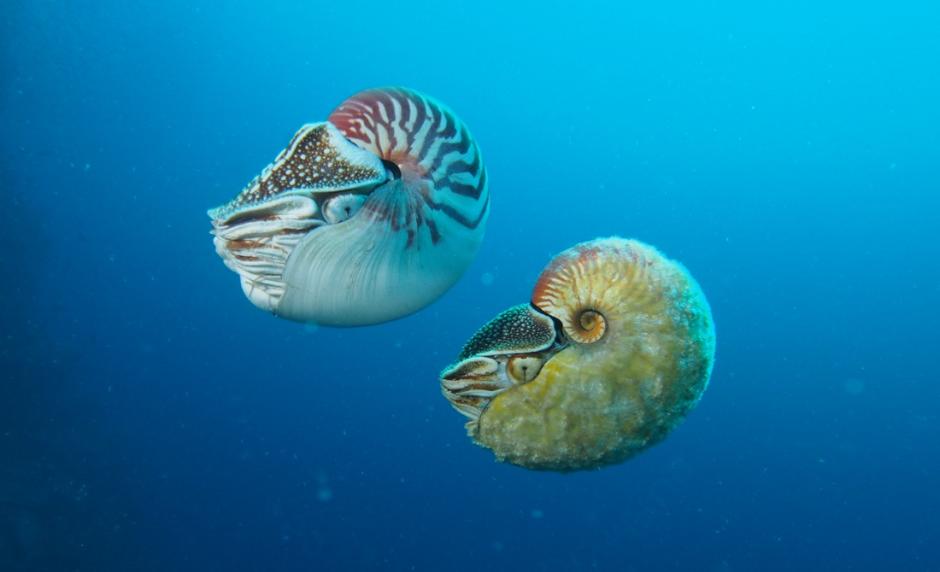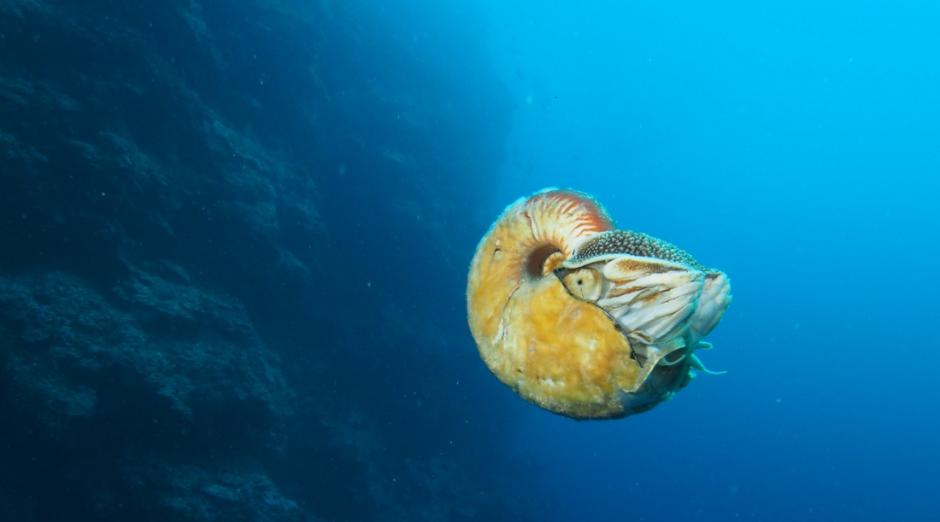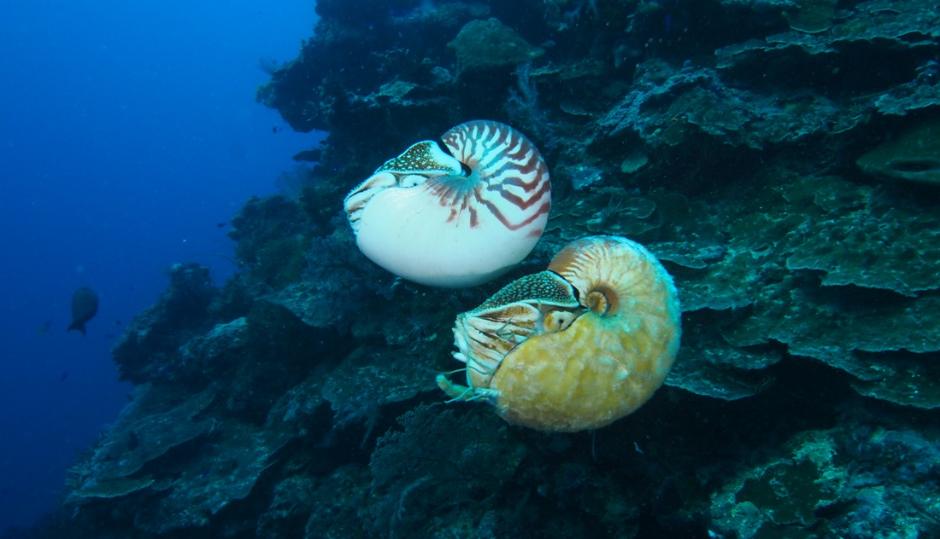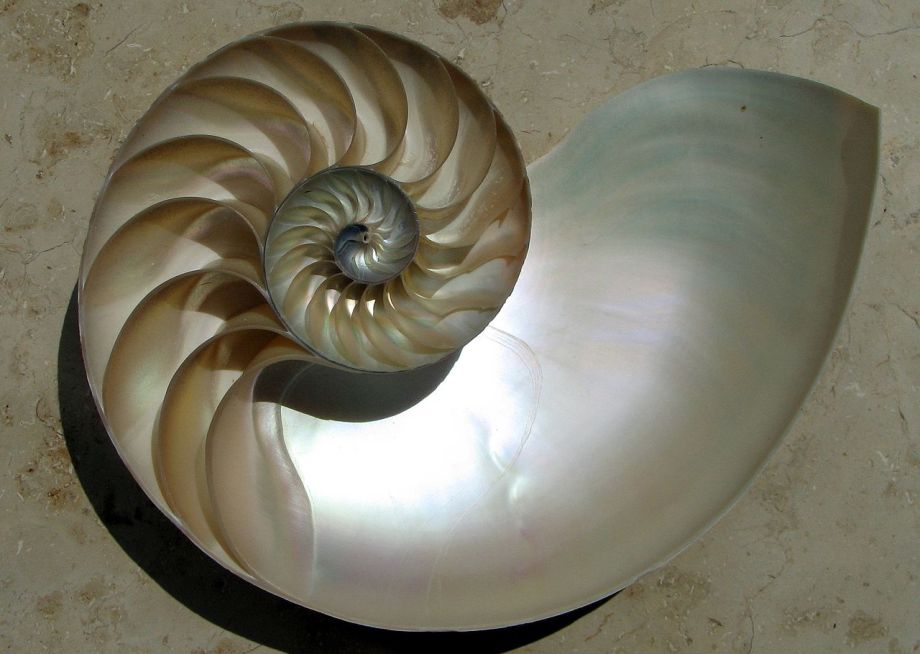August 30 - September 5, 2015: Issue 229
Rare Nautilus Sighted For the First Time in Three Decades off of Ndrova Island in Papua New Guinea

Nautilus pompilius (left) swimming next to a rare Allonautilus scrobiculatus (right) off of Ndrova Island in Papua New Guinea.Peter Ward
Rare Nautilus Sighted For the First Time in Three Decades off of Ndrova Island in Papua New Guinea
August 25, 2015: James Urton, University of Washington News and Information
In early August, biologist Peter Ward returned from the South Pacific with news that he encountered an old friend, one he hadn’t seen in over three decades. The University of Washington professor had seen what he considers one of the world’s rarest animals, a remote encounter that may become even more infrequent if illegal fishing practices continue.
The creature in question is Allonautilus scrobiculatus, a species of nautilus that Ward and a colleague had previously discovered off of Ndrova Island in Papua New Guinea. Nautiluses are small, distant cousins of squid and cuttlefish. They are an ancient lineage of animal, often christened a “living fossil” because their distinctive shells appear in the fossil record over an impressive 500 million year period. Ward says this recent sighting of Allonautilus indicates that there is still much to learn about these creatures.
“Before this, two humans had seen Allonautilus scrobiculatus,” said Ward, who holds appointments at the UW in both the Department of Biology and the Department of Earth and Space Sciences. “My colleague Bruce Saunders from Bryn Mawr College foundAllonautilus first, and I saw them a few weeks later.”
Those sightings were in 1984, when Ronald Reagan was finishing his first term as president and the oldest millennials were starting preschool. Ward and Saunders collected several Allonautilus scrobiculatus specimens for analysis and realized that their gills, jaws, shell shape and male reproductive structures differ significantly from other nautilus species.
“Some features of the nautilus — like the shell giving it the ‘living fossil’ label — may not have changed for a long time, but other parts have,” said Ward.
Allonautilus also sports a distinctive accessory clearly visible in photographs.
“It has this thick, hairy, slimy covering on its shell,” said Ward. “When we first saw that, we were astounded.”
This slimy nautilus turned out to be even more elusive than its siblings. Aside from another brief sighting by Saunders in 1986, Allonautilusdisappeared until July 2015, when Ward returned to Papua New Guinea to survey nautilus populations. Since nautiluses are expert scavengers, Ward and his colleagues set up “bait on a stick” systems each evening — fish and chicken meat suspended on a pole between 500 and 1,300 feet below the surface — and filmed activity around the bait for 12 hours.
“We started using this approach in 2011,” said Ward. “This year, there were about 30 guys involved and each day we would all watch the movies from the night before at 8X speed. There were a lot of ‘ohs’ and ‘ahs’.”
One night’s footage from a site off of Ndrova Island showed an Allonautilus approach the bait after a 31-year absence from Ward’s life. It was soon joined by another nautilus, and the two fought for access to the bait until a sunfish arrived on the scene.
“For the next two hours, the sunfish just kept whacking them with its tail,” said Ward.
The team also used baited traps to capture several nautiluses, including Allonautilus, at a depth of about 600 feet. Since most nautiluses do not like the heat, the researchers brought them to the surface in chilled water to obtain small tissue, shell and mucous samples and measure the dimensions of each animal. They then transported the animals back to their capture site and released them.
Ward and his colleagues used this information to determine the age and sex of each animal, as well as the diversity of each nautilus population in the South Pacific. Through these studies, they have learned that most nautilus populations are isolated from one another because they can only inhabit a narrow range of ocean depth.
“They swim just above the bottom of wherever they are,” said Ward. “Just like submarines, they have ‘fail depths’ where they’ll die if they go too deep, and surface waters are so warm that they usually can’t go up there. Water about 2,600 feet deep is going to isolate them.”
These restrictions on where nautiluses can go mean that populations near one island or coral reef can differ genetically or ecologically from those at another. The findings also pose a challenge for conservationists.
“Once they’re gone from an area, they’re gone for good,” said Ward.
Illegal fishing and “mining” operations for nautilus shells have already decimated some populations, Ward said. This unchecked practice could threaten a lineage that has been around longer than the dinosaurs were and survived the two largest mass extinctions in Earth’s history. In September, the U.S. Fish and Wildlife Service will decide whether to advocate for nautiluses to become a protected species under the Convention on International Trade in Endangered Species of Wildlife Fauna and Flora, or CITES treaty. Such protection could curb international trade in nautilus shells, with the aim of reducing nautilus harvests across the Pacific.
“As it stands now, nautilus mining could cause nautiluses to go extinct,” said Ward.
Ward hopes to see Allonautilus again, especially since he would like to study how this species, which arose relatively recently according to genetic tests, behaves differently from other nautiluses. Its rarity makes this endeavor challenging.
“It’s only near this tiny island,” said Ward. “This could be the rarest animal in the world. We need to know if Allonautilus is anywhere else, and we won’t know until we go out there and look.”
Ward’s main partners in this field season included Richard Hamilton and Manuai Matawai from the Nature Conservancy and Greg Barord from the City University of New York. More than 30 fisheries experts, guides and local residents in the Admiralty Islands and the Bismarck Archipelago of Papua New Guinea also provided crucial aid and support, Ward said. Their work is funded by National Geographic, the National Science Foundation’s Division of Polar Programs and the Tiffany & Co. Foundation.

Allonautilus scrobiculatus off the coast of Ndrova Island in Papua New Guinea.Photo by Peter Ward

Nautilus pompilius swimming above a rare Allonautilus scrobiculatus off the coast of Ndrova Island in Papua New Guinea. Photo by Peter Ward
Nautilus
The nautilus (from the Latin form of the original Greek ναυτίλος, 'sailor') is a pelagic marine mollusc of the cephalopod family Nautilidae, the sole extant family of the superfamily Nautilaceae and of its smaller but near equal suborder, Nautilina.
It comprises six living species in two genera, the type of which is the genus Nautilus. Though it more specifically refers to species Nautilus pompilius, the name chambered nautilus is also used for any species of the Nautilidae.
A cephalopod is any member of the molluscan class Cephalopoda (Greek plural κεφαλόποδα, kephalópoda; "head-feet"). These exclusively marine animals are characterized by bilateral body symmetry, a prominent head, and a set of arms or tentacles (muscular hydrostats) modified from the primitive molluscan foot. Fishermen sometimes call them inkfish, referring to their common ability to squirt ink. The study of cephalopods is a branch of malacology known as teuthology.
Cephalopods became dominant during the Ordovician period, represented by primitive nautiloids. The class now contains two, only distantly related, extant subclasses: Coleoidea, which includes octopuses, squid, and cuttlefish; and Nautiloidea, represented by Nautilus and Allonautilus. In the Coleoidea, the molluscan shell has been internalized or is absent, whereas in the Nautiloidea, the external shell remains. (2.)
Nautilidae, both extant and extinct, are characterized by involute or slightly evolute shells that are generally smooth, with compressed or depressed whorl sections, straight to sinuous sutures, and a tubular, generally central siphuncle. Having survived relatively unchanged for millions of years, nautiluses represent the only living members of the subclass nautiloidea, and are often considered "living fossils."
The name "nautilus" originally referred to the pelagic octopuses of the genus Argonauta, otherwise known as paper nautiluses, as the ancients believed these animals used their two expanded arms as sails.
Nautiluses are the sole living cephalopods whose bony body structure is externalized as a shell. The animal can withdraw completely into its shell and close the opening with a leathery hood formed from two specially folded tentacles. The shell is coiled, aragonitic, nacreous and pressure resistant, imploding at a depth of about 800 metres (2,600 ft). The nautilus shell is composed of two layers: a matte white outer layer, and a striking white iridescent inner layer. The innermost portion of the shell is a pearlescent blue-gray. The osmeña pearl, contrarily to its name, is not a pearl, but a jewellery product derived from this part of the shell.
Internally, the shell divides into camerae (chambers), the chambered section being called the phragmocone. The divisions are defined by septa, each of which is pierced in the middle by a duct, the siphuncle. As the nautilus matures it creates new, larger camerae, and moves its growing body into the larger space, sealing the vacated chamber with a new septum. The camerae increase in number from around four at the moment of hatching to thirty or more in adults.
To swim, the nautilus draws water into and out of the living chamber with its hyponome, which uses jet propulsion. While water is inside the chamber, the siphuncle extracts salt from it and diffuses it into the blood. The animal adjusts its buoyancy only in long term density changes by osmosis, either removing liquid from its chambers or allowing water from the blood in the siphuncle to slowly refill the chambers. This is done in response to sudden changes in buoyancy that can occur with predatory attacks of fish, which can break off parts of the shell. This limits nautiluses in that they cannot operate under the extreme hydrostatic pressures found at depths greater than approximately 800 metres (2,600 ft), and in fact implode at about that depth, causing instant death.

Cutaway of a nautilus shell showing the chambers by Chris 73
Nautiluses are much closer to the first cephalopods that appeared about 500 million years ago than the early modern cephalopods that appeared maybe 100 million years later (ammonoids and coleoids). They have a seemingly simple brain, not the large complex brains of octopus, cuttlefish and squid, and had long been assumed to lack intelligence. But the cephalopod nervous system is quite different from that of other animals, and recent experiments have shown not only memory, but a changing response to the same event over time.
The lifespan of nautiluses may exceed 20 years, which is exceptionally lengthy for a cephalopod. However, nautiluses typically reach sexual maturity when they are about 15 years old.
Nautilus pompilius is the largest species in the genus. One form from northwestern Australia, once called Nautilus repertus, may reach 26.8 centimetres (10.6 in) in diameter. However, most nautilus species never exceed 20 centimetres (7.9 in). Nautilus macromphalus is one of the smallest species, usually measuring only 16 centimetres (6.3 in). A dwarf population from the Sulu Sea (Nautilus pompilius suluensis) is even smaller, with a mean shell diameter of 115.6 mm.
There is growing concern that nautiluses are being greatly overfished not just for the shape of their shells, but also for the nacreous inner shell layer, which is used as a pearl substitute. Because there are currently no national or international regulations protecting this ancient creature, biologist Peter Ward, from the University of Washington, says "there is a horrendous slaughter going on out there." (3.)
Nautiluses are only found in the Indo-Pacific, from 30° N to 30° S latitude and 90° to 175° E longitude. They inhabit the deep slopes of coral reefs. N. p. pompilius is by far the most common and widespread of all nautiluses. It is sometimes called the emperor nautilus due to its large size. The distribution of N. p. pompilius covers the Andaman Sea east to Fiji and southern Japan south to the Great Barrier Reef.Two subspecies of N. pompilius have been described: N. p. pompilius and N. p. suluensis (4.)
Their limited ecological range and the late onset of their sexual maturity combined with this overfishing has led to recent investigations into the need to protect them from possible endangerment or extinction though no regulations yet exist and thus the nautilus remains unprotected.
 Nautilus shells were popular items in the Renaissance cabinet of curiosities and were often mounted by goldsmiths on a thin stem to make extravagant nautilus shell cups, such as the Burghley Nef, mainly intended as decorations rather than for use. Small natural history collections were common in mid-19th-century Victorian homes, and chambered nautilus shells were popular decorations.
Nautilus shells were popular items in the Renaissance cabinet of curiosities and were often mounted by goldsmiths on a thin stem to make extravagant nautilus shell cups, such as the Burghley Nef, mainly intended as decorations rather than for use. Small natural history collections were common in mid-19th-century Victorian homes, and chambered nautilus shells were popular decorations.
The Burghley Nef is a silver-gilt salt cellar made in Paris in 1527–28 (or possibly earlier). In medieval France the word 'nef' was applied to various types of boat-shaped containers, including the most magnificent objects intended for the dining tables and buffets of the rich. Apart from having an obvious ornamental quality, their function was to hold personal pieces of cutlery or, as in this case, salt or spices—there is a detachable compartment on the rear deck, which was presumably passed around the table. This nautilus shell, mounted in silver, was a rare natural curiosity.
The Burghley Nef would have been placed in front of the most important person at table as a mark of their status. At the foot of the mast, engaged in a game of chess, are the tiny figures of the lovers Tristan and Iseult who, according to the legend, mistakenly drank a love potion and suffered tragic consequences. The Burghley Nef is currently in the collection of the Victoria and Albert Museum in London. It was discovered at Burghley House in 1956 and sold on 17 July 1959 when the 6th Marquess of Exeter auctioned part of his silver collection. (5.)
Right: The Burghley Nef, 1527-1528, France, V&A Museum no. M.60-1959 Techniques - Nautilus shell with parcel-gilt silver mounts, raised, chased, engraved and cast, and pearls. Dimensions - Height 34.8 cm, Width 20.8 cm, Depth 12.2 cm, Weight 0.78 kg Source: http://images.vam.ac.uk/indexplus/page/Home.html Category: Metalwork in the V&A
References
1. Nautilus. (2015, August 26). In Wikipedia, The Free Encyclopedia. Retrieved from https://en.wikipedia.org/w/index.php?title=Nautilus&oldid=677997276
2. Cephalopod. (2015, August 27). In Wikipedia, The Free Encyclopedia. Retrieved from https://en.wikipedia.org/w/index.php?title=Cephalopod&oldid=678141376
3. (New York Times, Loving the Chambered Nautilus to Death by William J. Broadoct, Octoer 24th, 2011)
4. Chambered nautilus. (2015, May 7). In Wikipedia, The Free Encyclopedia. Retrieved from https://en.wikipedia.org/w/index.php?title=Chambered_nautilus&oldid=661299800
5. Burghley Nef. (2015, August 15). In Wikipedia, The Free Encyclopedia. Retrieved from https://en.wikipedia.org/w/index.php?title=Burghley_Nef&oldid=676188327